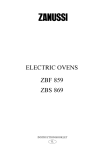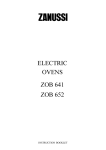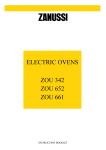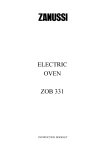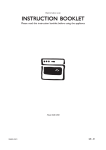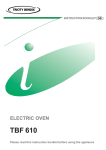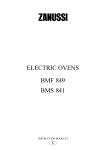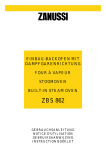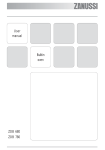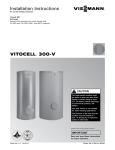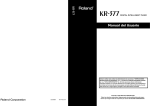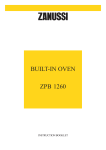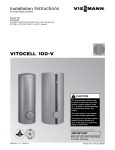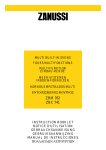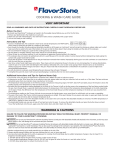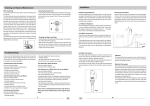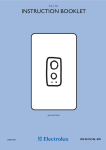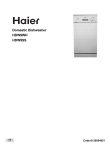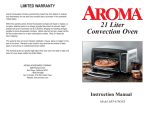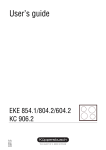Download Zanussi ZBF 610 User's Manual
Transcript
BUILT-IN OVEN ZBF 610 INSTRUCTION BOOKLET IL English Important Safety Information These warnings are provided in the interest of safety. You MUST read them carefully before installing or using the appliance. Installation It is mandatory that all operations required for the installation are carried out by a qualified or competent person, in accordance with existing rules and regulations. It is dangerous to alter the specification in any way. Once you removed all packaging from the appliance, ensure that it is not damaged and the electric cable is in perfect conditions. Otherwise, contact your dealer before proceeding with the installation. Service Child Safety This appliance has been designed to be operated by adults and children under supervision. Young children MUST NOT be allowed to tamper with the controls or play near or with the oven. Accessible parts of this appliance may become hot when it is in use. Children should be KEPT AWAY until it has cooled. During use 2 This appliance has been designed for cooking edible foodstuff only and MUST NOT be used for any other purposes. Ensure that all control knobs are in the OFF position when not in use. Should you connect any electrical tool to a plug near this cooking appliance, ensure that electric cables are not in contact with it and keep them far enough from the heated parts of this appliance. If the appliance is out of order, disconnect it from the electric supply. Do not leave untensils containing foodstuffs, e. g. fat or oil in or on the appliance. This could cause damage in case the appliance is inadvertently switched on. Always place the dripping pan in position to collect fat when using the grill or when cooking meat. Pour a little water into the dripping pan to avoid smoke and unpleasant smells. Always use oven gloves to remove pans from the oven. For hygiene and safety reasons, this appliance should be kept clean at all times. A build-up of fats or other foodstuff could result in a fire. Disconnect the appliance from the electrical supply, before carrying out any cleaning or manteinance work. Some parts of the appliance are covered by a shockproof plastic film. Remove this film before using the oven. This appliance is meant to operate with a singlephased connection to 230V electrical supply. An eventual 400V poliphasic connection without earth wire will destroy the oven and the hob, if fitted. The manufacturer disclaims any responsability should all the safety measures not be carried out. Under no circumstances should you attempt to repair the appliance yourself. Repairs carried out by unexperienced persons may cause injury or serious malfunctioning. Refer to your local Service Centre. Always insist on genuine spare parts. Environmental Information After installation, please dispose of the packaging with due regard to safety and the environment. When disposing of an old appliance, make it unusable, by cutting off the cable. It is most important that this instruction book is be retained with the appliance for future reference. Should the appliance be sold or transferred, always ensure that the book is left with the appliance in order that the new owner can get to know the functions of the appliance and the relevant warnings. Guide to Use the instructions The following symbols will be found in the text to guide you throughout the Instructions: Safety Instructions F Step by step instructions for an operation Hints and Tips Environmental information MANUFACTURER: ELECTROLUX ZANUSSI S.p.A. Viale Bologna, 298 47100 FORLÌ (Italy) Contents For the User For the Installer Important Safety Information 2 Technical Data 10 Description of the Oven 3 Installation 11 When the oven is first installed 5 Electrical connection 12 Using the Oven 6 Cooking Tables 7 Cleaning and maintenance 8 Something not working... 9 Technical Assistance 9 Description of the Oven Oven function control knob (Fig. 1) The oven function control knob can have the following symbols and functions: Conventional cooking - The heat comes from both the top and bottom element, ensuring even heating inside the oven. Bottom heating element - The heat comes from the bottom of the oven only. Fan cooking - This allows you to roast or roast and bake simoultaneously using any shelf, without flavour transference. Inner grill element only - can be used for grilling small quantities. Double Grill - The full grill element will be on. Defrost Setting - This setting is intended to assist 0 FO 2676 Fig. 1 in thawing of frozen food. 3 Thermostat control knob (Fig. 2) 100 0 150 Oven control light (I) 20 Once the oven temperature has been selected, the temperature light will come on and remain on until the oven has reached the correct setting; after that, it will go on and off with the thermostat, showing how the temperature is being maintained. MAX Thermostat control light (°C) 50 Turn the thermostat control knob to select temperatures between 50°C and 250°C / MAX. FO 2673 It will come on every time an heating element is set on operation. Fig. 2 End of cooking programmer (Fig. 3) 15 10 5 90 75 30 60 45 This device allows you to make the oven switch off automatically once the preset time is over. An acousitic signal will be heard when the cooking is completed.The cooking duration can be set up to 90 minutes maximum. Place food in the oven and turn the oven function control knob and the thermostat control knob on the required settings. Turn the timer knob to maximum time position, then turn it back to set the required cooking time. When the cooking time is over, an acoustic alarm will sound and the oven will switch off automatically. Turn the timer knob on to set the oven on manual operation. Turn the the oven function and thermostat control knobs to zero. FO 2675 Fig. 3 The Safety Thermostat This oven is provided with a safety thermostat. In case of malfunctioning of the main thermostat, and consequent over-heating, the safety device will stop the power supply to the appliance. If this happens, call your local Zanussi Service Centre. Under no circumstances should you attempt to repair the appliance yourself. The cooling fan The cooling fan is designed to cool the walls of the oven and the components of the oven itself. The fan switches on automatically after a few minutes of cooking. Warm air is blown out through the aperture near the oven door handle. When the oven is switched off, the fan will remain on in order to cool the oven and kitchen cabinets properly, after which it switches off automatically. NOTE: The fan may run up to 45 minutes after cooking has been completed. Leaving the door ajar will lessen the cooling time. FO 2259 Fig. 4 When the oven is first installed Before cooking for the first time, carefully wash the oven accessories. F Once the oven has been installed: a) set the thermostat knob to MAX (250); b) switch the oven function control knob to conventional ); cooking ( c) allow the oven to run empty for approximately 45 minutes; d) open a window for ventilation. During this time, an unpleasant odour may be emitted. This is absolutely normal, and is caused by residues of manufacturing. Repeat this operation for the grill and fan cooking function. Once this operation is carried out, let the oven cool down, then clean the oven cavity with a soft cloth soaked in warm soapy water. Using the Oven Fig. 5 FO 2161 To open the oven door, always catch the handle in its central part (Fig. 5). Always cook with the oven door closed. Stand clear when opening the drop down oven door. Do not allow it to fall open - support the door using the door handle, until it is fully open. The oven has four shelf levels. The shelf positions are counted from the bottom of the oven as shown in the diagram. Do not place cookware directly on the oven base. Hints and Tips Condensation and steam When food is heated it produces steam in the same way as a boiling kettle. The oven vents allow some of this steam to escape. However, always stand back from the oven when opening the oven door to allow any build up of steam or heat to release. If the steam comes into contact with a cool surface on the outside of the oven, e.g. a trim, it will condense and produce water droplets. This is quite normal and is not a fault with the oven. To prevent discoloration, regularly wipe away condensation and also soilage from surfaces. Cookware Use any oven proof cookware which will withstand temperatures of 250°C. Baking trays, oven dishes, etc. should not be placed directly against the grid covering the fan at the back of the oven, or placed on the oven base. Do not use baking trays larger than 30 cm x 35 cm (12 in x 14 in) as they will restrict the circulation of heat and may affect performance. 4 3 2 1 FO 0019 Fig. 6 The effects of dishes on cooking results Dishes and tins vary in their thickness, conductivity, colour, etc. which affects the way they transmit heat to the food inside them. A Aluminium, earthenware, oven glassware and bright shiny utensils reduce cooking and underneath browning. B Enamelled cast iron, anodized aluminium, aluminium with non-stick interior and coloured exterior and dark, heavy utensils increase cooking and underneath browning. Using the oven Always cook with the oven door closed Conventional cooking Turn the oven function control knob to the relevant symbol ( ) and set the thermostat knob on the required temperature. If you need more heat from the bottom of the oven, turn the oven function control knob to (bottom heating element only). Fan cooking Turn the oven function control knob to the relevant symbol ( ) and set the thermostat knob on the required temperature. The fan behind the back panel circulates heated air into the oven. If you need to cook more than one dish in the fan oven at the same time, place the shelves on the first and third position from the bottom (Fig. 7). If you are cooking only one dish in the fan oven, use the lower positions, as this will give you better results. Grilling Turn the oven function control knob to the relevant symbol and set the thermostat knob on the required temperature. With the setting on the "double grill" function, you will obtain even heating on the whole surface of the dish. When grilling meat or fish, spread a little oil on them and always place them on the oven grid. The shelf level depends on the thinckness of the food. Always place the dripping pan at the lowest level, with some water in it, to avoid smoke and unpleasant smells. Defrosting Hints and Tips on Cooking Fish and Meat You can place meat in oven proof dishes, or directly on the oven shelf. In this case, remember to place the dripping pan in the first position from the bottom with some water in it. The dripping pan will avoid the falling of melted fat on the oven base. White meat, poultry and fish in general, need a medium temperature cooking (between 150 and 175 °C). If you need to cook red meat (slightly browned on the outside and more gently cooked in the inside), a higher temperature (between 200 and 250 °C) for a short time is recommended. Hints and Tips on baking Cakes usually need a medium temperature cooking, between 150 and 200 °C. A short oven pre-heating (about 10 minutes) is recommeded when cooking cakes or baking. Once the cooking has been started, keep the oven door closed during all the cooking time, and check the cooking results through the oven door glass. Hints and Tips on grilling If you need to grill meat or fish, place them directly on the shelf after spreading a little oil on them. In the grill function, heat comes only from the top element. Therefore, you need to adjust the cooking level depending on meat or fish's thickness. Always remember to place the dripping pan in the lower position with some water in it. Turn the oven function control knob to the relevant symbol ( ) and set the thermostat knob on the OFF position (symbol : l). The oven fan operates without heat and circulates the air, at room temperature, inside the oven. 6 The temperatures inside the oven can reach 250°C. Always ensure that you are using oven proof baking trays, oven dishes, etc. Do not place pans, biscuit pans or aluminium foil directly on the base of the oven. This could cause a heat build-up which could affect the performance of the oven and damage the oven enamel. Carefully supervise cookings with fats or oil, since these types of foodstuff can result in a fire, if overheated. For the same reason, be careful when placing or removing food in the oven, not to let any fat or oil fall on the oven base. If this happens, carefully clean the oven to avoid unpleasant smells or smoke. Fan cooking 4 3 2 1 FO 0351 Fig. 7 Cooking Tables Conventional and fan cooking WEIGHT (GR.) 1000 500 500 250 1000 1200 1000 1500 1200 1000 4000 1500 3000 1200 1000 800 TYPE OF DISH 4 3 2 1 Level Cakes Whipped up kneading Leavened kneading Shortbread dough Butter-milk cheese cake Apple cake Strudel Jam-tart Small cakes Biscuits Meringues Bread and Pizza White bread Rye bread Bread rolls Pizza Flans Pasta flan Vegetable flan Quiches Lasagne Meat Beef Pork Veal English roast beef Lamb Chicken Turkey Duck Goose Hare Fish Whole Fillets Cooking time Fan Oven Conventional Cooking 4 3 2 1 temp. °C Level temp. °C NOTES minutes 2 2 2 1 1 2 2 2 2 2 180 180 180 175 180 175 180 180 180 100 2 (1 and 3)* 2 (1 and 3)* 2 (1 and 3)* 2 2 (1 and 3)* 2 (1 and 3)* 2 (1 and 3)* 2 (1 and 3)* 2 (1 and 3)* 2 (1 and 3)* 160 160 160 150 160 150 160 160 160 100 45 ~ 60 20 ~ 35 20 ~ 30 60 ~ 80 40 ~ 60 60 ~ 80 45 ~ 60 15 ~ 25 10 ~ 20 90 ~ 120 1 2 2 1 200 200 200 220 2 2 2 (1 and 3)* 2 (1 and 3)* 175 175 175 200 45 ~ 60 30 ~ 45 20 ~ 35 20 ~ 35 2 2 2 2 200 200 200 200 2 (1 and 3)* 2 (1 and 3)* 2 (1 and 3)* 2 175 175 175 175 40 ~ 50 45 ~ 60 35 ~ 45 45 ~ 60 2 2 2 2 2 2 2 2 2 2 200 200 200 220 200 200 200 175 175 200 2 2 2 2 2 2 2 2 2 2 175 175 175 200 175 175 175 160 160 175 50 ~ 70 100 ~ 130 90 ~ 120 50 ~ 70 110 ~ 130 60 ~ 80 210 ~ 240 120 ~ 150 150 ~ 200 60 ~ 80 2 2 200 200 2 (1 and 3)* 2 (1 and 3)* 175 175 40 ~ 60 30 ~ 40 1 piece In bread pan 8 rolls In baking pan On grid On grid On grid On grid Leg Whole Whole Whole Whole Cut in pieces 2 fishes 4 fillets NOTE: Cooking times do not include pre-heating time. We reccomend a short oven pre-heating (about 10 minutes) before baking or cooking pizza. (*) If you need to cook more than one dish at the same time, we recommend you to place them on the levels quoted between brackets. The times given in the table are intended as a guide only. Only experience will enable you to determine the correct setting to suit your personal requirements. Grilling Quantity TYPE OF DISH 4 3 2 1 PIECES WEIGHT Level Steaks Chops Sausages Chicken (cut in pieces) Kebabs Chicken (breast) Tomatoes Fish (fillets) Sandwiches Toast 4 4 8 6 4 4 8 4 4 4 800 600 500 800 700 400 500 400 Cooking time (minutes) Grilling 4 4 4 3 4 4 4 4 4 4 temp. °C max max max max max max max max max max Upper side 10 12 10 30 12 13 12 8 8 2~3 Lower side 8 8 6 20 10 10 6 1 7 Cleaning and maintenance General Cleaning Before carrying out any cleaning or manteinance work, always disconnect the appliance from the electrical supply, and allow it to cool down. When using spray cleaning products, be careful not to spread them on the heating elements or on the thermostat sensor. Never use harsh abrasives, steel wool or cleaners with bleach, as they could damage the enamel and the oven door glass. Grease Filter When cooking meat, the grease filter must be fitted over the oven fan by clipping it over the vents in the back panel. This will prevent a built-up of fat on the fan impellor. Do not use abrasive materials to clean the seal. The grease filter is dishwasher proof. When cooking is completed and the oven has cooled down, remove the filter by pushing the protruding tongue on the filter upward. (See Fig. 8) Wash the filter after use using warm soapy water. Fit the grease filter only when roasting. The Oven Cavity The enamelled oven cavity is best cleaned whilst the oven is still warm. It is advisable to wipe the oven over with a soft cloth soaked in warm soapy water after each use. However, from time to time, it will be necessary to do a more complete cleaning, using a proper oven cleaner. In case of particularly tough stains, you can use stainless steel cleaning products or some warm vinegar. If cooking fruits, some over-heated natual acids can squeeze and settle on the oven enamel, causing stains quite difficult to remove. This could affect the enamel brightness, but it will have no consequence on the oven performances. To avoid these stains to be burnt out during the next cooking, carefully clean the oven cavity after all fruits cookings. The Oven Door and its gasket Before cleaning the oven door, we recommend you to remove it from the oven. F Fig. 8 FO 0018 Fig. 9 FO 0288 Fig. 10 FO 0287 Proceed as follows: a) open the oven door completely; b) find the hinges linking the door to the oven (Fig. 9); c) unlock and turn the small levers located on the two hinges (Fig. 9); d) handle the door by its left- and right-hand sides, then slowly turn it towards the oven until it is half-closed; e) gently pull the oven door off its site (Fig. 9); f) place it on a steady plan. Clean the oven door glass with warm water and a softh cloth only. Once the cleaning is carried out, refit the oven door, following the procedure in reverse. The correct operation of the oven is ensured by a gasket placed round the edge of the oven cavity. Periodically check the condition of this gasket. If necessary, clean it without using abrasive cleaning products. If the gasket shows to be damaged, call you local Service Centre. Do not use the oven until it has been repaired. Replacing the Oven Light Ensure the electricity supply is switched off before carrying out this operation. The oven bulb has to comply to these features: a) resistant to temperatures of 300 °C; b) electric rate: 230 V - 50 Hz; c) electric power rate: 25 W; d) connection type: E 14. To replace the bulb, proceed as follows (Fig. 10): a) push in and turn the glass lid anticlockwise; b) remove tha faulty bulb; c) replace it with a new one; d) refit the glass lid; e) switch on the electricity supply. 8 Oven Shelves Supports and Shelf To clean the oven shelves, soak in warm soapy water and remove stubborn marks with a well wetted soap impregnated pad. Rinse well and dry with a soft cloth. Something not working... If the appliance is not working correctly, please carry out the following checks, before contacting your local Service Centre. SYMPTOM SOLUTION n The oven does not come on uCheck that both a cooking function and a temperature have been selected or uCheck the appliance is wired in properly, and the socket switch or the switch from the mains supply to the oven are ON. n The oven temperature light does not come on uTurn the thermostat knob on a temperature or uTurn the oven function control knob on a function. n The oven light does not come on uTurn the oven function control knob on a function or uBuy a new oven light bulb, asking for it to your local Service Centre and replace it by following the instruction provided in this booklet. n It takes too much time to finish the dishes, or they are cooked too fast. uRefer to the contents of this booklet, especially to the chapter "Using the oven". n Steam and condensation settle on the food and the oven cavity. uLeave dishes inside the oven no longer than 15-20 minutes after the cooking is completed. Technical Assistance If after the checks listed in the previous chapter, the appliance still does not work correctly, contact your local Service Centre, specifying the type of malfunctioning, the appliance model (Mod.), the product number (Prod. No.) and the serial number (Ser. No.) marked on the identification plate. This plate is placed on the front external edge of the oven cavity. Original spareparts, certified by the product manufacturer and carrying this symbol are only available at our Service Centre and authorized spareparts shops. Mod. PROD. NO. SER. NO. MOD. PROD. NO. TYPE SER. NO. 9 Technical Data Heating elements ratings Recess dimensions in-column 58,0 cm Bottom heating element undertop 59,1 cm Top heating element Width 56,0 cm Full Oven (Top+Bottom) (1000 + 800) 1800 W Depth 55,0 cm Simple Grill heating element 1750 W Double Grill heating element 2550 W Oven rear heating element 2000 W Height Oven cavity dimensions Height 32,5 cm Width 42,0 cm Depth 39,0 cm Volume 53,5 l 1000 W 800 W Convection fan 30 W Cooling fan 25 W Oven lamp 25 W Voltage tension (50 Hz) 230 V Maximum power rating (230V - 50Hz) 2600 W Energy consumption in accordance with EC directive 2002/40/CE 8 May 2002 MANUFACTURER ZBF 610 MODEL ENERGY EFFICIENCY CLASS CONVENTIONAL FORCED AIR CONVECTION A ENERGY CONSUMPTION-HEATING FUNCTION (kW) CONVENTIONAL FORCED AIR CONVECTION STEAM USABLE VOLUME (LITRES) SIZE: - ** SMALL - *** MEDIUM - **** LARGE TIME TO COOK STANDARD LOAD (min.) CONVENTIONAL FORCED AIR CONVECTION THE AREA OF THE LARGEST BAKING SHEET (cm²) AB CD E F G MORE EFFICIENT 10 LESS EFFICIENT 0,99 0,79 53,5 50 44 1210 _ USABLE VOLUME< 35 l ** 12 l< _ USABLE VOLUME< 65 l *** 35 l< _ USABLE VOLUME **** 65 l< Installation The following instructions are meant to a qualified technician, in order to allow him carry out the installation in compliance with the rules in force. The building-in and the electrical connection fo the appliance must be carried out by a qualified and authorized technician only. Building In It is important that the dimensions and materials of the surround or cabinet into which the oven will be built are correct and will withstand a temperature increase. A correct installation will have to ensure a proper protection against contact with electric parts or merely functionally isolated parts. All the units meant to ensure protection have to be fitted not to be taken away without using any tool. We recommed not to install the appliance near refrigerators or freezer, since the heat could affect the performance of these appliances. Fig. 12 FO 0290 Oven dimensions The oven dimensions are shown in Fig. 11. In-Column recess dimensions The recess must have the dimensions shown in Fig. 12. Undertop recess dimensions The recess must have the dimensions shown in Fig. 13. Fig. 11 FO 0374 Fig. 13 FO 0292 Securing the oven to the cabinet - Fit the appliance into the cabinet recess. Open the oven door and secure the oven to the kitchen cabinet with four wood screws, which fit the holes provided in the oven frame (Fig.14). When installing an electric plate hob over the oven, the hob's electrical connection and the oven's one have to be carried out separately, for security reasons and to let the oven be taken off the unit easier, if necessary. Fig. 14 FO 0039 11











